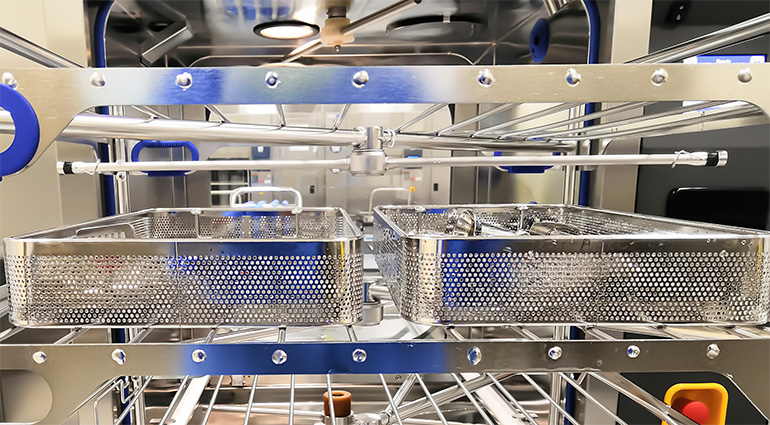
- Importance of Proper Equipment Selection
- Design Considerations for an Efficient SPD
- Flow and Layout of the SPD
- Conclusion
The Sterile Processing Department (SPD) is the backbone of any Ambulatory Surgery Center (ASC), ensuring that all surgical instruments are properly cleaned, sterilized, and ready for use. Proper planning and design of the SPD are crucial for operational efficiency, patient safety, and staff safety. This article explores the critical aspects of designing an SPD in a new ASC, focusing on equipment selection, space allocation, and compliance with industry standards.
Importance of Proper Equipment Selection
- Steam Sterilizers
- Chamber Size: Selecting the correct chamber size for steam sterilizers is crucial. Larger instruments require larger chambers, and planning for this from the outset prevents costly modifications later.
- Location Considerations: If steam sterilizers need to be stacked next to each other, adequate space and service areas around the units must be planned to ensure maintenance accessibility and operational efficiency. Some models require the space of a service person on one side of the unit for maintenance and repairs.
- Instrument Washers/Disinfectors
- Hand Washing Hazards: Relying on manual washing of instruments poses significant safety risks to employees. Automated washers/disinfectors are essential to maintain high hygiene standards and protect staff from exposure to harmful pathogens.
- Ultrasonic Washers: Newer instruments often require an ultrasonic cleaning cycle. Integrating instrument washers or sonic washers into the SPD design ensures compliance with manufacturers’ instructions for use (IFUs).
- Cart Washers
- Space Planning: If the ASC requires a cart washer, it must be planned for during the design phase. Adequate space and appropriate utility connections should be considered early to avoid disruptions later. Please note that redesign of SPD can be very expensive, especially once the surgery center is fully operational.
- Low-Temperature Sterilization
- Chamber Size: Instruments are increasingly sophisticated and larger, necessitating full-size chambers for low-temperature sterilization processes.
- ETO Sterilization: Many new IFUs specify ethylene oxide (ETO) sterilization instead of high-temperature autoclaves. Planning for ETO sterilization, including budget allocation, is essential to meet these requirements. ASP and Steris are both leading manufacturers of Low Temp Sterilizers for the ASC market. Both manufacturers have options for full size and tabletop size low temp sterilizers.
Design Considerations for an Efficient SPD
- Consultation with Experts
- Equipment Planners and Manufacturers: Collaborating with experienced equipment planners and manufacturers ensures that the SPD is designed to meet current and future needs. Their expertise helps in selecting the right equipment and planning for optimal space utilization. There is a fine balance between overdoing a design of an SPD and adding the right amount of equipment, a good equipment planner should be able to provide advise here. It is recommended that the SPD tech(s) have an input in the design phase as they are the ones who will use this space the most on a daily basis.
- Utility Requirements
- Electrical Voltages: Proper electrical planning prevents the need for expensive retrofitting. Ensure that voltage requirements for all equipment are met.
- Drains, Water Inlets, and Pressure: Adequate planning for drains, water inlets, water pressure, and temperature is crucial. Water quality also needs to be considered to prevent equipment damage and ensure effective sterilization.
- Scope Reprocessing
- Specialized Equipment: If the ASC plans to use scopes, proper reprocessing equipment and space must be integrated into the design. This includes automated endoscope reprocessors (AERs) and drying cabinets. Some drying cabinets now come with micron level filters, air blowout features, etc. Some manufacturers here include Mass Medical, Innerspace, Olympus, Pedigo, etc.
- Future-Proofing for Robotics and Orthopedic Surgery
- Robotic Surgery Considerations: With the increasing use of robotic surgery, planning for all IFUs, including required washers and sterilizers, is vital. This forward-thinking approach ensures the SPD can accommodate robotic instruments efficiently. Some instruments for robotics require a 15 minute ultrasonic cycle, some may even need a longer cycle.
Flow and Layout of the SPD
- Decontamination Sinks
- Dirty and Clean Areas: The layout must separate dirty and clean areas to prevent cross-contamination. Decontamination sinks should be easily accessible and designed to handle the volume and size of instruments being processed.
- Prep and Packing Tables/Stations
- These are essential to workflow and the layout of the design should be considered carefully during the initial SPD design phase.
- Critical Workflow Design
- Proper Flow: An efficient SPD design ensures a smooth workflow from decontamination to sterilization and storage. This involves strategically placing equipment and workstations to minimize movement and enhance efficiency.
Conclusion
A well-designed Sterile Processing Department is the cornerstone of an efficient and safe Ambulatory Surgery Center. Proper planning, from selecting the right equipment to ensuring utility requirements are met, prevents costly redesigns and enhances operational efficiency. Engaging with equipment planners and manufacturers early in the process ensures that the SPD can meet current demands and accommodate future technological advancements. By prioritizing the design of the SPD, ASCs can ensure the highest standards of patient care, staff safety, and overall efficiency.
Protégé Plan is an ASC Equipment Planning firm. We are happy to consult with you or help in the planning of your surgery center including the proper design of your Sterile Processing Department. We specialize in overall design flow for an efficient ambulatory surgery center.